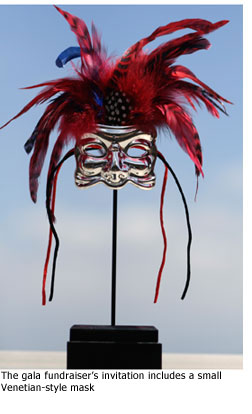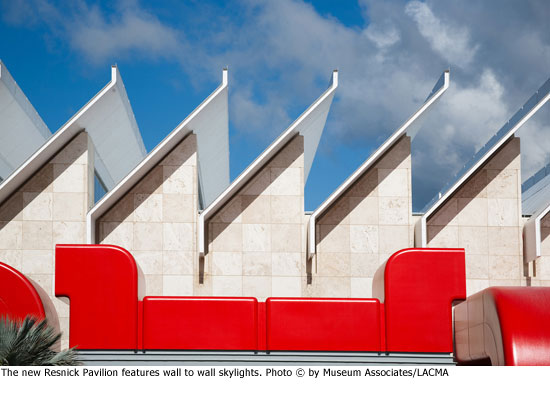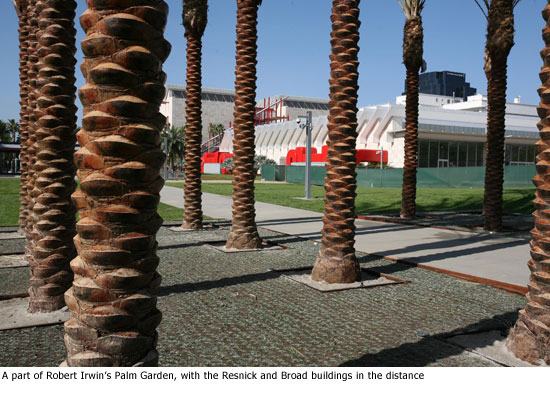At LACMA, a new gallery stirs to life
May 26, 2010
The fences are coming down and the invitations are going out—clear signs that a new era in the “transformation” of the Los Angeles County Museum of Art is just months away.
Workers can now be seen putting the final touches on the new Lynda and Stewart Resnick Exhibition Pavilion, a striking 45,000 square-foot gallery by Italian architect Renzo Piano, who also designed the neighboring Broad Contemporary Art Museum.
Meanwhile, 3,000 elaborate invitations featuring a small, silvery Venetian mask with feathers began arriving this week for a gala fundraiser on September 25 to celebrate the Resnick gallery’s “unmasking.”
Guests, who’ll pay from $2,500 a ticket to $100,000 per table to help fund LACMA’s special exhibitions, will be the first to tour the building and its three inaugural exhibits, which include highlights from the Resnicks’ collection and displays of ancient Mexican sculpture and European fashion from 1700 to 1915.
The gallery is scheduled to open to the general public on October 2.
The new gallery was built thanks to a $45 million gift made by the Resnicks in 2008.
 Stewart Resnick is CEO of the Roll Corporation, an L.A.-based holding company that owns extensive tree farms and companies that include Teleflora, Fiji Water and POM Wonderful. Lynda Resnick, the marketing guru behind POM’s iconic curvy bottles, has served as a LACMA trustee since 1992. She designed and donated the unusual invitations for the gallery that carries her name.
Stewart Resnick is CEO of the Roll Corporation, an L.A.-based holding company that owns extensive tree farms and companies that include Teleflora, Fiji Water and POM Wonderful. Lynda Resnick, the marketing guru behind POM’s iconic curvy bottles, has served as a LACMA trustee since 1992. She designed and donated the unusual invitations for the gallery that carries her name.
Initially, the Resnicks were going to donate $25 million for a new grand entrance to LACMA. But when the oil company, BP, offered to fund the entrance, the Resnicks said they’d donate nearly twice as much for construction of the new exhibition hall. The couple also pledged to donate $10 million for art.
The architect, Piano, designed the expansive one-story gallery as a complement to his earlier LACMA work directly to the south, the three-story Broad, which opened in 2008.
The similarities between the two buildings are obvious—travertine-clad walls topped by a skylight-covered roof topped with iconic “fins.” Taken together, the two buildings help create a more unified look on a campus where, until now, each building has differed dramatically from its neighbors.
“You can start to see with the Resnick Pavilion almost complete that the idea was not really to make a building but to make a place,” Piano told a sold-out audience at a “director’s series” conversation with LACMA Director Michael Govan in late April.
The exteriors of both buildings also contain dramatic accents of “Renzo Red,” a signature bright scarlet that the Italian favors. At the Broad, he uses red for the exterior stair cases and escalators. At the Resnick, he uses it on the heating and air conditioning systems, which are visible on the building’s exterior, only recently coming into full view when fencing was removed.
With those fences down, visitors also can now see more of artist Robert Irwin’s “Palm Garden,” the last stage of which is near the Resnick Pavilion. Irwin, who also designed the Getty Center’s garden, began his work at LACMA in 2008 with landscape architect Paul Comstock. Some of the palms are planted in rows, while others are set individually in oxidized steel planters. Between them are lush green lawns.
Already, the garden is exerting a strong pull on visitors.
“It’s such an inviting space,” Eryn Talevich, who was leading a toddler art class at LACMA on a recent Sunday, noted admiringly. “It makes you want to lie down and enjoy the sun.”
For an early review by Los Angeles Times architecture critic Christopher Hawthorne, click here.
Posted 5/26/10
















 405 bridge work causes a stink
405 bridge work causes a stink